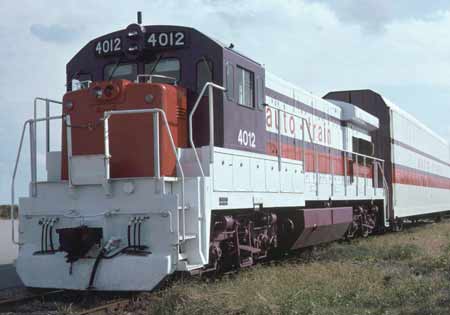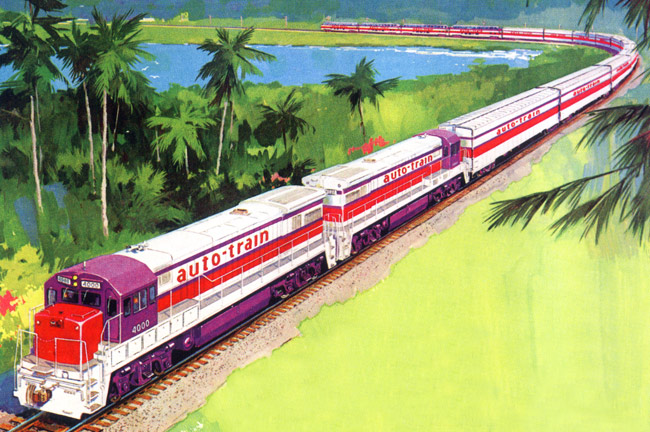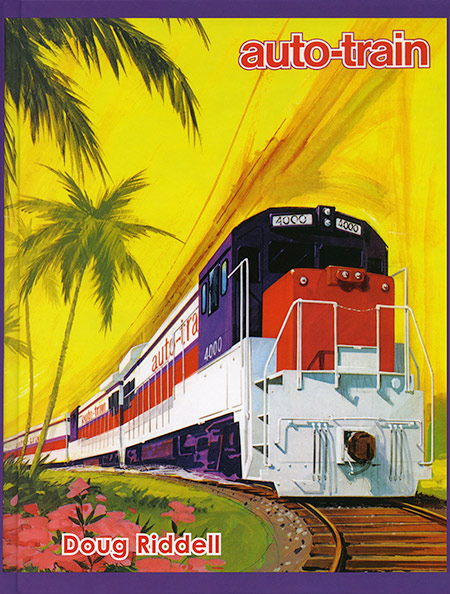
|
|
||||
|
The
1971 - 1981 "You'll never drive all the way again!", said the ad. And for ten glorious years you didn't have to. From December 6, 1971 to May 1, 1981 the auto-train Corporation took happy passengers -- and their cars -- over 1800 miles round trip from Washington, DC (and, for a time, Louisville, KY) to sunny Florida aboard their red, white and purple auto-trains. __________________
|
 |
|||
|
In the late 1960s, the US government sponsored a study to determine if there was a market for trains that could carry both passengers and their autos as had been done successfully in Europe. The conclusion of the study was "yes". But the government also determined it could be run at a profit and so should be left to private industry. With almost all of the major railroads turning their passenger equipment over to Amtrak in the early 1970s, there would be no takers from among the usual suspects. Enter a young attorney named Eugene K. Garfield. While working as an assistant to the Transportation Secretary, Garfield became familiar with the government's study. The 33 year old used his personal savings to set up the Auto-Train Corporation in 1970. With financial backing from a NY investment bank, Garfield contracted with the SCL and the RF&P railroads to operate a train consisting of Auto-Train Corporation equipment from an Auto-Train terminal in Lorton, VA in the Washington, DC area to Sanford, FL just a few miles from the new Walt Disney World. With dozens of railroads eager to rid themselves of surplus passenger equipment, the Auto-Train Corporation was able to purchase some of the finest equipment ever built -- and at bargain prices. To create this new breed of train, the corporation needed to identify suitable auto carriers. The solution was found in Canadian National bi-level auto carriers. These would carry passengers' cars in enclosed safety and would be put at the front of the consist. And what a consist it was! Every coach was a dome car. The best domes of the Santa Fe, Union Pacific and Western Pacific were brought together with sleepers and diners from the ACL, SAL, L&N, N&W and others. Rounding out each consist was a steam generator car and, in later years, a caboose. To pull this unique train would take new, high-horsepower diesels. Auto-Train initially purchased five new GE U36B diesels (eventually acquiring 13), and the corporation was ready to run. The first train left Lorton on December 6, 1971 for the 856 mile trip to Sanford. Thanks to a large advertisement in the New York Times the train was an instant success. Thousands of passengers booked passage on the new service and the young and enthusiastic onboard staff garnered the train rave reviews. Passengers would arrive at the terminal and proceed to drop off their vehicles for loading onto the auto carriers. Next, the passengers would board the deluxe passenger cars of the train. With all the passengers and vehicles loaded, the passenger cars would be coupled onto the auto carriers and the train would head out. The trip in either direction was nonstop, save for servicing stops and crew changes. Upon arrival, the automobiles would be offloaded and, at least in the case of arrival at Sanford, the passengers would be on their way to fun in the sun. Going home would reverse the process. The service was so successful that soon a second route was added -- from Louisville, KY to Sanford. The new service wasn't nearly as well received and put a drag on corporate finances. The next six years would be a struggle. Even as the Louisville service was reworked and wound down, a trio of accidents took their toll. Insurance premiums went up and passenger revenues went down. On Thursday April 30, 1981, the last auto-trains departed Lorton and Sanford, passing in the night. When they arrived at their destinations May 1, the Auto-Train Corporation was done. The company was gone, but the concept had been proven. The service was reborn two years later as Amtrak started its own Auto Train service using the same Lorton and Sanford facilities. The concept pioneered by Eugene Garfield and the staff of the Auto-Train Corporation is, today, one of Amtrak's highest revenue routes! |
||||



